Creating a stunning outdoor space requires more than just planting. A flower garden planner helps you organize your ideas and turn them into reality. Whether you’re working with a small border or a large plot, strategic planning ensures both beauty and functionality.
From Nova Scotia to Ohio, gardeners have successfully designed layouts ranging from 34-foot farm plots to compact 3-foot borders. These real-world examples show how adapting to different climates and sizes can lead to thriving spaces. Digital tools like Seedtime simplify the process by offering free planning features, including frost date customization.
Planning isn’t just about aesthetics. It also supports ecosystems by encouraging pollination and biodiversity. By analyzing sunlight, bloom cycles, and maintenance needs, you can create a space that’s both visually appealing and sustainable.
Key Takeaways
- Strategic planning enhances both beauty and functionality in outdoor spaces.
- Real-world examples show success across various climates and sizes.
- Digital tools like Seedtime simplify year-round scheduling.
- Planning supports ecosystems through pollination and biodiversity.
- Key aspects include sunlight analysis, bloom cycles, and maintenance.
Why Use a Flower Garden Planner?
Strategic organization is the key to a flourishing outdoor space. A flower garden planner goes beyond basic organization, offering practical benefits that make your efforts more efficient and rewarding. Tools like Bricks ‘n Blooms track over 25 variables, including soil pH and frost dates, ensuring your plants thrive in every season.
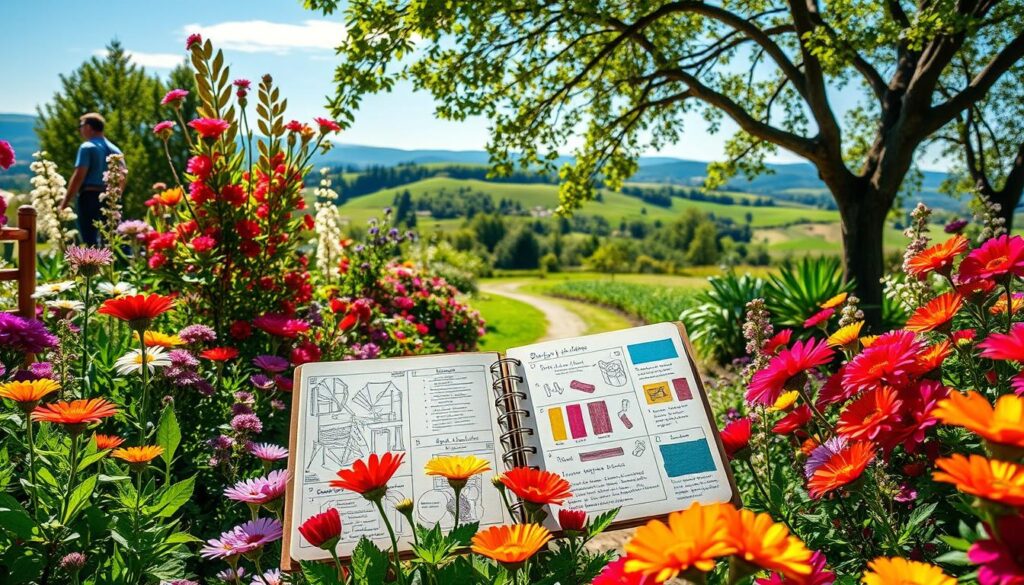
Common frustrations like forgotten plant varieties or inconsistent bloom times become a thing of the past. For example, an Ohio gardener increased their cut-flower yield by 60% in just two years by using a planner. Additionally, tracking seed performance can save money—compare $0.99 seed packs to the cost of mature plants.
Planners also offer cross-benefits. They support vegetable pollination and natural pest control, creating a healthier ecosystem. According to a Penn State study, journal-keepers have a 73% higher success rate in maintaining their outdoor spaces. This makes a planner an essential tool for both beginners and experienced enthusiasts.
If you’re new to organizing your outdoor area, check out this beginner’s guide to get started. With the right tools and planning, you can create a space that’s both beautiful and sustainable year after year.
Understanding Your Garden Space
To create a thriving outdoor area, understanding your space is the first step. Knowing the specifics of your garden area, including sunlight patterns and soil conditions, ensures your plants thrive. Let’s break down the key factors to assess before you start designing.
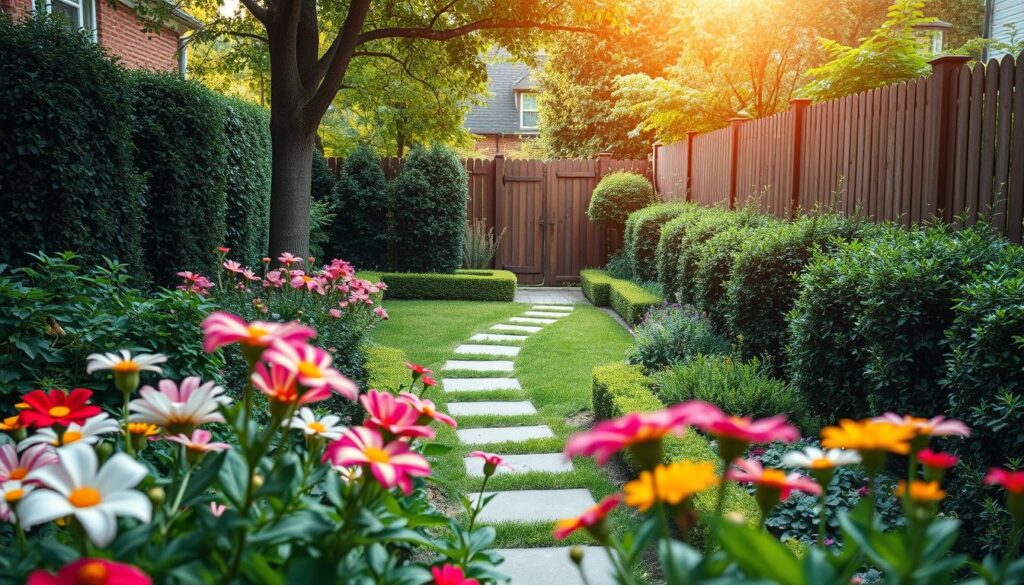
Assessing Sunlight and Soil Conditions
Sunlight is one of the most critical factors for plant growth. Use free apps like Sun Surveyor to map sunlight patterns throughout the day. This helps you identify the best spots for sun-loving plants or shade-tolerant varieties.
Next, evaluate your soil type. DIY methods like jar sedimentation can help you determine if your soil is sandy, loamy, or clay-based. For more accuracy, consider lab analysis. A Virginia gardener, for example, increased blooms by 40% by using reflective mulches to adapt to clay soil.
Measuring Your Garden Area
Accurate measurements are essential for planning. Traditional tools like wheel measurers work well, but modern phone AR tools offer convenience and precision. Knowing your garden area helps you allocate space effectively for different plant types.
Zone-specific tips can also make a big difference. For instance, protecting peonies in Minnesota requires different strategies than growing desert lilies in Arizona. Tools like Seedtime offer microclimate adjustments, making it easier to adapt to unique conditions.
Choosing the Right Flowers for Your Garden
Selecting the perfect plants for your outdoor area can transform it into a vibrant sanctuary. Whether you’re aiming for year-round color or specific soil adaptations, understanding your options is key. With over 750 varieties in the Seedtime database, there’s something for every space and climate.
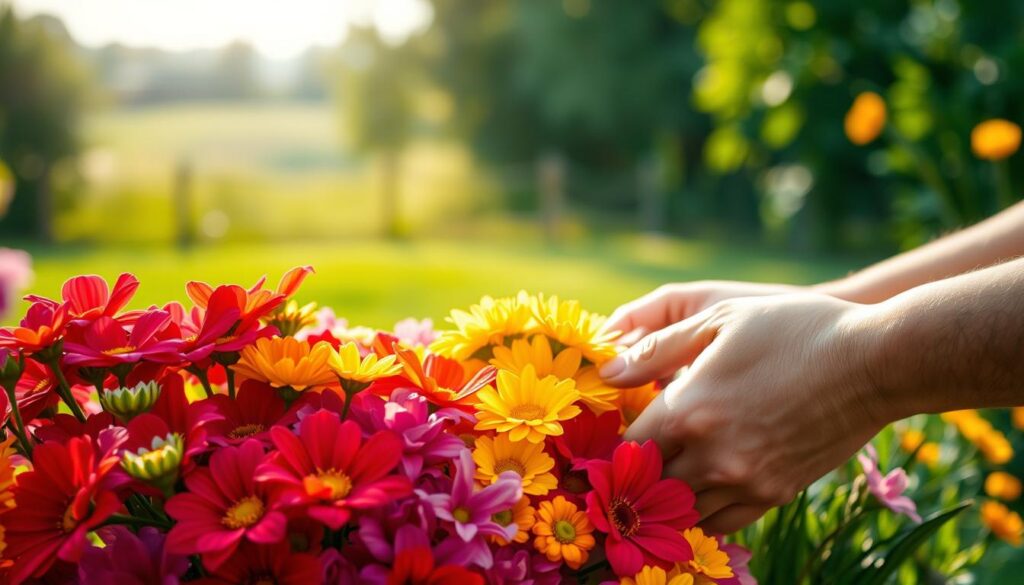
Seasonal Blooming Flowers
Seasonal blooming ensures your space remains lively throughout the year. For USDA zones 3-9, consider pairing early tulips with late-blooming asters. This combination provides continuous color from spring to fall.
An Illinois cut-flower farm achieved a 12-month production cycle by carefully selecting plants for each season. Their success highlights the importance of planning for year-round beauty.
Flower Varieties for Different Soil Types
Understanding your soil type is essential for plant health. For heavy soils, Black-eyed Susans and Bee Balm are excellent choices. These varieties thrive in dense, clay-rich environments.
Sandy soils, on the other hand, benefit from Lavender and California Poppies. These plants are drought-tolerant and adapt well to loose, well-draining conditions. Marigolds are another great option, reducing nematodes in clay by 31%.
| Soil Type | Recommended Varieties | Benefits |
|---|---|---|
| Heavy (Clay) | Black-eyed Susans, Bee Balm | Thrives in dense soil, supports pollinators |
| Sandy | Lavender, California Poppies | Drought-tolerant, well-draining |
| Loamy | Marigolds, Asters | Reduces pests, continuous blooming |
By choosing the right varieties for your soil and season, you can create a thriving, colorful outdoor space. Experiment with different combinations to find what works best for your unique environment.
Designing Your Flower Garden Layout
Transforming your outdoor area into a cohesive and vibrant space starts with thoughtful design. A well-structured layout ensures your plants thrive while creating a visually appealing environment. Whether you’re working with small beds or expansive areas, strategic planning makes all the difference.
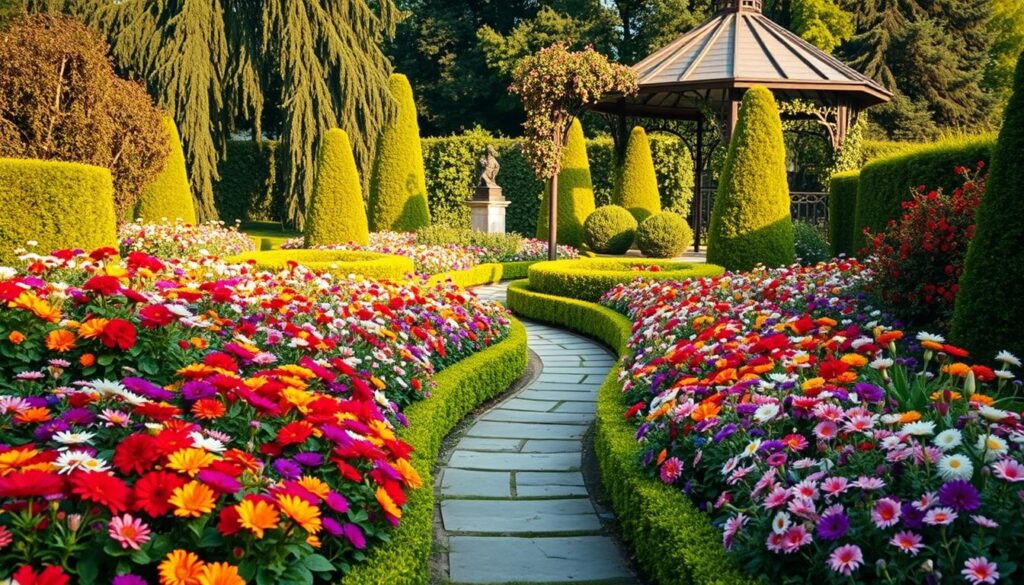
Creating a Balanced Garden Design
Balance is the foundation of any successful garden design. Using the “thriller-filler-spiller” method, you can create dynamic borders that increase visual appeal by 58%. Start with tall, eye-catching varieties like hollyhocks, then layer in mid-height fillers such as cosmos, and finish with low-growing spillers like alyssum.
Color coordination also plays a key role. Monochromatic schemes create a calming effect, while complementary colors add energy. For example, pairing purple salvia with yellow marigolds creates a striking contrast that draws the eye.
Incorporating Height and Texture
Adding height and texture is a great way to make your outdoor space more engaging. Combine feathery cosmos with bold canna leaves for a mix of soft and dramatic elements. This contrast not only enhances visual interest but also supports biodiversity by attracting different pollinators.
Pathways are another essential element. Ensure they are at least 36 inches wide for accessibility and use materials like gravel or stepping stones to blend functionality with aesthetics. Evergreen framework plants provide year-round structure, ensuring your beds remain appealing even in winter.
| Design Element | Examples | Benefits |
|---|---|---|
| Height | Hollyhocks, Delphiniums | Adds vertical interest, creates focal points |
| Texture | Cosmos, Canna Leaves | Enhances visual and tactile appeal |
| Color Schemes | Monochromatic, Complementary | Sets mood and enhances aesthetics |
Preparing Your Garden Beds
Proper preparation of your outdoor area sets the stage for thriving greenery. Whether you’re starting fresh or revamping existing garden beds, the right groundwork ensures your plants grow strong and healthy. Let’s explore the essential steps to get your space ready.

Soil Preparation Techniques
Healthy soil is the foundation of any successful outdoor area. Begin by testing your soil’s pH and texture. For a budget-friendly way, try the lasagna layering method. Layer cardboard, compost, and straw to enrich the soil naturally.
If your soil needs adjustment, use lime to raise pH or peat moss to lower it. A simple chart can guide you on quantities per square foot. For example, 5 pounds of lime per 100 square feet raises pH by 0.5. These small changes can make a big difference in plant health.
Mulching and Fertilizing Tips
Mulching is a cost-effective way to retain moisture and suppress weeds. A 3-inch layer of wood chip mulch can reduce watering needs by 25%. Compare options like cedar and cocoa hulls to find the best fit for your budget and soil type.
For fertilizing, organic options like fish emulsion and compost tea are both effective. Fish emulsion provides quick nutrients, while compost tea improves soil structure over time. Create a schedule to ensure your plants get consistent nourishment.
- Lasagna layering: Cardboard, compost, and straw for enriched soil.
- pH adjustment: Lime or peat moss for balanced soil.
- Organic fertilizers: Fish emulsion for quick results, compost tea for long-term health.
- Mulch comparison: Cedar for durability, cocoa hulls for aesthetics.
- Raised beds: Cedar for natural look, composite for longevity.
By focusing on these preparation techniques, you’ll create a solid foundation for your garden beds. With the right soil, mulch, and fertilizer, your outdoor area will thrive season after season.
Planting and Caring for Your Flowers
Growing healthy and vibrant greenery starts with proper planting and care. Whether you’re a beginner or an experienced enthusiast, understanding the right techniques ensures your plants thrive. From depth charts to smart irrigation, let’s explore the best practices for nurturing your outdoor space.
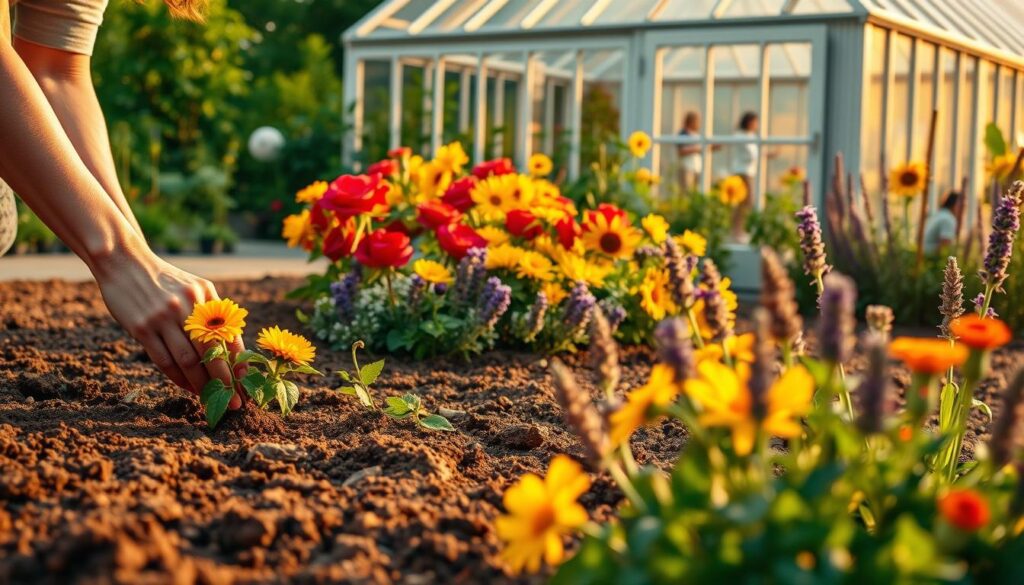
Planting Techniques for Optimal Growth
Proper planting is the foundation of healthy growth. Start by checking depth charts for over 50 varieties to ensure each plant is placed correctly. For example, marigolds should be planted 1/4 inch deep, while tulips need 6-8 inches. This small step can make a big difference in root development.
Companion planting is another effective strategy. Pairing marigolds with tomatoes reduces aphids by 31%, creating a natural pest barrier. Tools like Seedtime’s successional planting feature have boosted yields by 70%, making it easier to plan for continuous growth.
Watering and Pest Control Strategies
Watering your garden the right way is crucial. Drip irrigation systems, like those from Rachio or Orbit, cut disease risk by 45% and conserve water. These app-controlled systems ensure your plants get consistent moisture without overwatering.
For pests, organic solutions are both effective and eco-friendly. Neem oil schedules and beer slug traps are simple yet powerful methods to protect your greenery. Deadheading is another key practice—remove spent blooms from daisies to encourage new growth, but avoid deadheading hydrangeas, as they bloom on old wood.
- Depth charts: Ensure proper planting depth for 50+ varieties.
- Companion planting: Marigold-tomato pairings reduce aphids naturally.
- Smart irrigation: Rachio and Orbit systems cut disease risk by 45%.
- Organic pest control: Neem oil and beer slug traps are effective solutions.
- Deadheading guide: Know which blooms need it (daisies) vs. don’t (hydrangeas).
By following these tips, you’ll create a thriving outdoor space that’s both beautiful and sustainable. For more beginner-friendly advice, check out this guide to get started on the right foot.
Maintaining Your Flower Garden Throughout the Year
Keeping your outdoor space vibrant all year requires consistent care and attention. Each season brings unique tasks that ensure your plants stay healthy and your area remains beautiful. From frost protection to pruning, a little effort goes a long way in maintaining a thriving environment.
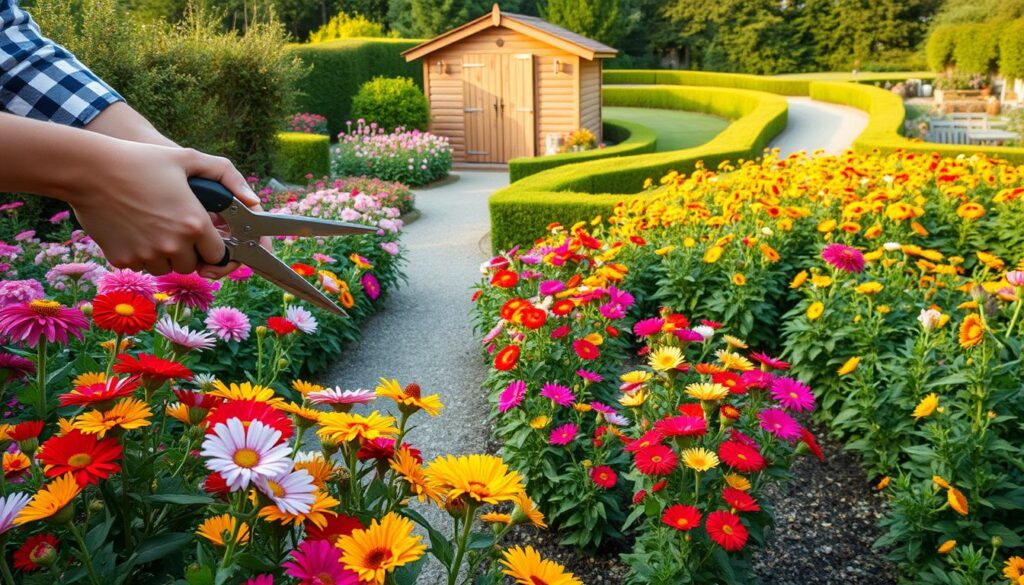
Seasonal Maintenance Tasks
Here’s a month-by-month checklist to help you stay on top of your outdoor tasks:
- January: Prune roses in zone 7 to encourage spring growth.
- April: Divide perennials like hostas to promote healthier plants.
- July: Implement heatwave rescue protocols, such as mulching and extra watering.
- October: Plant bulbs using depth charts for optimal spring blooms.
- December: Winterize tools and protect plants from frost with covers or mulch.
Tools like Seedtime’s frost protection guide can extend your growing season by up to 8 weeks. Almanac’s zone-specific pruning calendars also provide tailored advice for your area.
Pruning and Deadheading Tips
Pruning and deadheading are essential for maintaining healthy plants. Here’s how to do it right:
| Task | Best Time | Tips |
|---|---|---|
| Pruning Roses | Late Winter | Remove dead wood and shape for spring growth. |
| Deadheading Daisies | Summer | Remove spent blooms to encourage new flowers. |
| Pruning Hydrangeas | Early Spring | Avoid cutting old wood; focus on dead stems. |
By following these tips and staying on top of seasonal tasks, you’ll keep your outdoor space thriving all year long. Regular care ensures your garden remains a beautiful and sustainable retreat.
Using a Flower Garden Planner for Success
Maximizing the potential of your outdoor area starts with the right tools. A flower garden planner can help you stay organized and achieve your goals efficiently. Whether you prefer digital or analog methods, the right choice depends on your needs and preferences.
Digital tools like Seedtime offer a drag-and-drop editor that saves up to 7 hours per month. Bricks ‘n Blooms users report a 3x return on investment, making it a popular choice for serious enthusiasts. On the other hand, traditional paper journals provide a tangible way to track progress and jot down ideas.
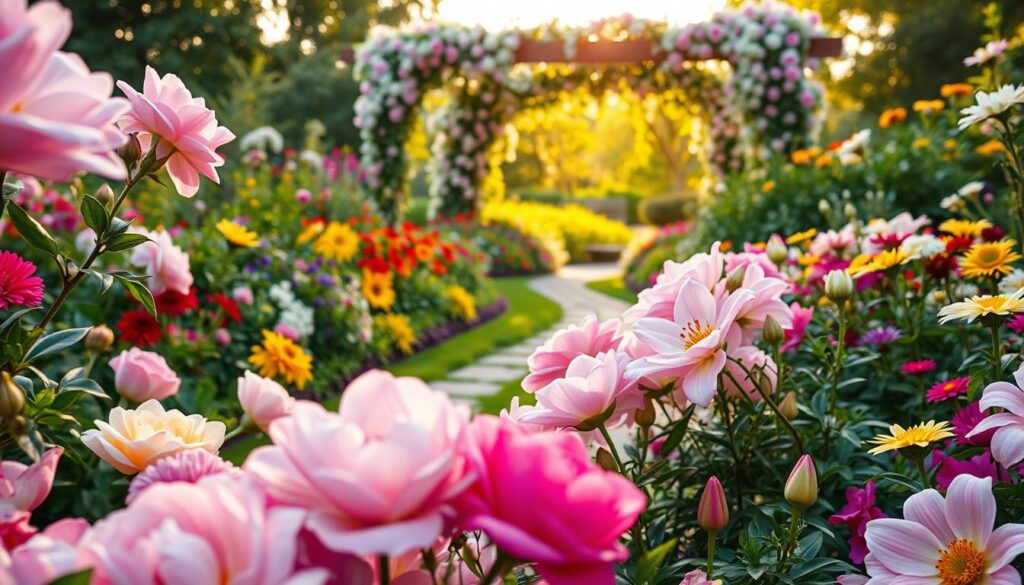
- Seedtime: Drag-and-drop editor, frost date customization, and smart sensor integration.
- Garden Planner: Detailed templates, cut-flower profit calculators, and pollinator logs.
- Paper Journals: Budget-friendly, customizable, and great for hands-on planners.
Tracking success metrics is another key benefit. For example, monitoring bloom density over three years can reveal patterns and help you refine your plan. A Michigan gardener documented their 5-year journey, showing how consistent use of a planner led to a thriving and sustainable garden.
Integration with smart sensors is a game-changer. Syncing your planner with devices like Rachio or Orbit ensures your plants receive the right amount of water and care. This seamless connection between planning and execution can save time and improve results.
By choosing the right tool and staying consistent, you can transform your outdoor area into a vibrant and productive space. Whether you’re a beginner or an experienced gardener, a flower garden planner is the way to achieve long-term success.
Conclusion
Designing a thriving outdoor retreat begins with thoughtful preparation. From soil tests to succession planting, every step in your plan ensures success. A Bricks ‘n Blooms survey found that 89% of users report higher satisfaction when using a flower garden planner.
Take inspiration from one gardener’s story: “My 400 sq.ft. cutting garden transformed my space and brought me joy year-round.” Tools like Almanac’s free templates and Seedtime’s trial can help you achieve similar results.
Start small with a 3×5′ starter bed blueprint. This manageable approach builds confidence and sets the foundation for larger projects. Remember, your spring blooms begin with autumn plans.
With the right tools and a clear plan, you can create a vibrant and sustainable outdoor space. Begin today and watch your vision come to life.

